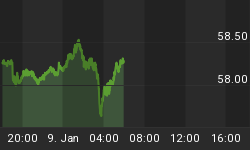Myth 1 of 3: Bond Yields Are Rising Due to the Fed's Insinuation at Tapering
Editor's note: The following article is the first in a series of three, reprinted with permission from market-leading financial forecasting firm Elliott Wave International. To read the full three-part report now, follow this link and download it for free
The consensus is that yields began to rise on or around May 22, also known as Bernanke Day. That was the day when U.S. Federal Reserve Chairman Ben Bernanke seemed to hint at tapering the Fed's $85-billion-per-month bond-buying program.
In reality, the rise in U.S. Treasury note rates actually began a year ago, back in mid-2012 - when yields on the 10-year note and 30-year bond stood at all-time record lows.
At the time, the raft of negative news coming out of the U.S. and Europe all but assured a rush into the perceived safety of U.S. Treasuries, as these news items from the time make plain:
"The US government is a big winner... [We] don't see any catalysts in the near-term to push yields higher as there is just so much ambiguity in the euro zone that keeps investors nervous." (WSJ, June 24, 2012)
"There's virtually no floor to how low yields go... I don't think we're going back to a level reflecting higher inflation or growth prospects for a long time." (CNN Money, June 1, 2012)
"Money is fleeing every place in the world and then coming here. The path of least resistance is to lower yields." (Bloomberg, July 23, 2012)

Yet, as this chart of 10-year Treasury notes shows - the floor for yields was actually laid in July 2012.
Before Bernanke Day, there was no fundamental reason for yields to start rising; inflation was low and economic activity was sluggish. By the time the majority of investors woke up to the silent uptrend that had long since started, the value of bonds had fallen.
In June 2012, Elliott Wave Theorist Editor and EWI President Robert Prechter teamed up with the editors of The Elliott Wave Financial Forecast for a first-ever special 10-page bonds report. Yields had been in a 31-year downtrend, and record amounts of money were flowing into bond funds. The analysis presented was quite contrary, and the title of the report did not mince words:
Major Top in the Bond Market:
Bond Yields are Poised to Begin Rising
On page six:
"The question is - When will rates begin rising? We think the answer is 'now.' Evidence is rapidly mounting that the trend in interest rates on high-grade debt is poised to reverse."

Among the key pieces of evidence cited in the report, here are two:
"As shown, the latest drop in yield has traced out five waves into Friday's new low as bond futures hit a new all-time high. This plunge in rates should mark at least a bottom and probably the bottom."
"The Commitment of Traders report shows that Large Speculators have been heavily invested in T-bond futures. Large Specs are not always wrong, but they are usually wrong when they follow the trend. The asterisks show times when their buying or selling was in concert with the trend, and in those cases the market was approaching a reversal."
In the end, the message from The Elliott Wave Theorist/The Elliott Wave Financial Forecast June 2012 special report was clear:
"The bull market in the bond market is aged and ripe for a reversal. Generally speaking, if you are invested in long-term debt, sell it."
The word "taper" was never mentioned in the entire piece.
This article is the first in a series of three, reprinted with permission from market-leading financial forecasting firm Elliott Wave International. To read the full three-part report, 3 Dangerous Myths About Rising Bond Yields, follow this link and download it for free.
















